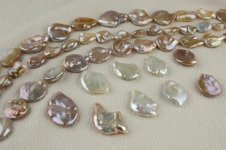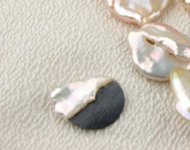kojimapearl
Well-known member
- Joined
- Feb 13, 2007
- Messages
- 445
Greetings from sunny California my fellow Pearls,
I thought you all may be interested in this short article written by Fuji Voll and the accompanying photos. Yes it's true that some Chinese fresh water pearls are being nucleated with a vinyl like material.... giving rise to his term "floppy coin".
ENJOY!
"Floppy" coin pearls are an innovation that reached the market in 2008. They are as a rule thicker than non-nucleated second harvest pearls, aka Chinese freshwater keshi, but otherwise resemble them in overall shape and surface texture. Sizes reaching over one inch (25.6mm), still rare among non-nucleated second-harvest freshwater pearls, are available in quantity. Many have slight curvature, but an excess of thinness and curvature that makes many non-nucleated second harvest pearls (a shape sometimes called "corn flake") awkward to string and set is largely eliminated.
This is achieved by the use of a thin nucleus of flexible plastic sheet, perhaps part of the second-harvest production stream that now includes bead nucleated flame pearls as well as regular coin pearls with flat shell nuclei and the more familiar non-nucleated pearls termed keshi by most vendors. A more detailed description of the second harvest production stream can be found on the bead-nucleated flame pearl page of the Pacific Pearls website (www.pacificpearls.us)
"Floppy" coins seem to constitute a distinct type, whose average market price lies between that of shell-nucleated coins and non-nucleated pearls. They are less easily recognized in strings and lots in which lightweight coins and non-nucleated pearls are mixed, and where bits of plastic cut in other than circular shape are used, but usually a close look at the shape suggests the presence of a thin and flexible nucleus. We have not done much drilling of floppy coin pearls, but the problems experienced with other non-shell nucleus materials such as aluminum coins or wax beads do not appear to be present. There are irregular spaces and sharp edges along the drill holes, however, that may be an obstacle to speedy restringing in some cases.
Unlike shell nuclei (bead and coin) these bits of plastic contribute little to the weight of the pearl. This might be a reason that so many vendors call them non-nucleated. The average price per weight of coin pearls is lower than that of non-nucleated second-harvest pearls, partly because coin pearl nuclei represent a considerable part of the weight of the pearl produced, and a pearl without nucleus is all nacre.
(Please excuse me if this subject has already been covered somewhere in this vast forum.)
With love and respect for all you pearl enthusiasts, we offer this fascinating tidbit of industry gossip.
Sincerely, Sarah
I thought you all may be interested in this short article written by Fuji Voll and the accompanying photos. Yes it's true that some Chinese fresh water pearls are being nucleated with a vinyl like material.... giving rise to his term "floppy coin".
ENJOY!
"Floppy" coin pearls are an innovation that reached the market in 2008. They are as a rule thicker than non-nucleated second harvest pearls, aka Chinese freshwater keshi, but otherwise resemble them in overall shape and surface texture. Sizes reaching over one inch (25.6mm), still rare among non-nucleated second-harvest freshwater pearls, are available in quantity. Many have slight curvature, but an excess of thinness and curvature that makes many non-nucleated second harvest pearls (a shape sometimes called "corn flake") awkward to string and set is largely eliminated.
This is achieved by the use of a thin nucleus of flexible plastic sheet, perhaps part of the second-harvest production stream that now includes bead nucleated flame pearls as well as regular coin pearls with flat shell nuclei and the more familiar non-nucleated pearls termed keshi by most vendors. A more detailed description of the second harvest production stream can be found on the bead-nucleated flame pearl page of the Pacific Pearls website (www.pacificpearls.us)
"Floppy" coins seem to constitute a distinct type, whose average market price lies between that of shell-nucleated coins and non-nucleated pearls. They are less easily recognized in strings and lots in which lightweight coins and non-nucleated pearls are mixed, and where bits of plastic cut in other than circular shape are used, but usually a close look at the shape suggests the presence of a thin and flexible nucleus. We have not done much drilling of floppy coin pearls, but the problems experienced with other non-shell nucleus materials such as aluminum coins or wax beads do not appear to be present. There are irregular spaces and sharp edges along the drill holes, however, that may be an obstacle to speedy restringing in some cases.
Unlike shell nuclei (bead and coin) these bits of plastic contribute little to the weight of the pearl. This might be a reason that so many vendors call them non-nucleated. The average price per weight of coin pearls is lower than that of non-nucleated second-harvest pearls, partly because coin pearl nuclei represent a considerable part of the weight of the pearl produced, and a pearl without nucleus is all nacre.
(Please excuse me if this subject has already been covered somewhere in this vast forum.)
With love and respect for all you pearl enthusiasts, we offer this fascinating tidbit of industry gossip.
Sincerely, Sarah


